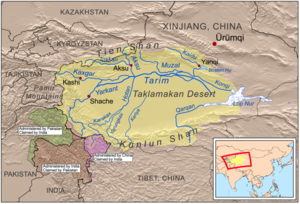Kashghar
Kashgar/ Kasgar (कासगर) or Kashi is a city in the western part of the Xinjiang Uyghur Autonomous Region of the People's Republic of China.
The modern Chinese name is 喀什 (Kāshí), a shortened form of the longer and less-frequently used (simplified Chinese: 喀什噶尔; traditional Chinese: 喀什噶爾; pinyin: Kāshígé’ěr).
Contents
Jat History
Kasania Jat clan is believed to be earlier inhabitants of this place Kasgar. [1]
H. W. Bellew writes that Bashgali is partly converted to Islam. Their women wear the horned head-dress which was peculiar to the ancient Jata of Kashghar. The proper name of this tribe is Bash or Posh, which represents the Pausikai of Herodotus, and Pasianoi of Strabo, and the Paishae of the Afghans. [2]
H. W. Bellew[3] writes that At the present day the ruling family in Kashkar is of the Kator tribe ; the senior branch of the family being designated Shah Katori, and the junior Khushwakhti. The Kator are spread all over Kashkar as a privileged class, their principal clan being the Sangalya. In subordination to them, and also a privileged class paying no taxes nor revenue, the
- Rono, called also, according to Major J. Biddulph (" Tribes of Hindoo Koosh ") Zundre and Haraiyo ; they are scattered over Kashkar and Yasin, and fill most of the government offices, and furnish the rulers with their ministers.
- Zundre is probably meant for Chandra, Brahman tribe. The rest of the population of the Kashkar valley is composed of agricultural tribes and the various artisan classes, who are designated fakir or "vassals". Most of them are of Rajput and Hindu origin ; one of the most numerous of these tribes is the Kalasha (Kalacha Rajput), another the Arniya, or Kho (Kachwaha). The
- Dangarik of Ashret and Kalkatak districts are Indian Jat ; the
- Shaoki, Jakani, and Kashi are also Indian. The
- Kashi probably represent the original Kashwaha (the Kachwaha of Balochistan) or Kash, after whom are named Kashkar and Hindu Kush.
History
Ptolemy (AD 90-168), in his Geography, Chapter 15.3A, refers to Kashgar as “Kasia”.[4]
The name is Middle Iranic in its origin, meaning "Kush Mountains" (from gar/ghar, "mountain", and Kush/Kâsh, being the same as the ethnonym of the Kushan Empire and the Hindukush mountains in the neighboring Afghanistan.
Alternate historical Romanizations for "Kashgar" include Cascar and Cashgar. Variant names include the approved name Shule, the Uyghur etc.
Han Dynasty
The earliest mention of Kashgar occurs when the Chinese Han Dynasty envoy traveled the Northern Silk Road to explore lands to the west.[5]
Another early mention of Kashgar is during the Former Han (also known as the Western Han Dynasty), when in 76 BC the Chinese conquered the Xiongnu, Yutian (Khotan), Sulei (Kashgar), and a group of states in the Tarim basin almost up to the foot of the Tian Shan mountains.
Ptolemy speaks of Scythia beyond the Imaus, which is in a “Kasia Regio”, probably exhibiting the name from which Kashgar and Kashgaria (often applied to the district) are formed. The country’s people practised Zoroastrianism and Buddhism before the coming of Islam.
In the Hanshu (Book of the Former Han), which covers the period between 125 BC and 23 AD, it is recorded that there were 1,510 households, 18,647 people and 2,000 persons able to bear arms. By the time covered by the Hou Hanshu (roughly 25 to 170), it had grown to 21,000 households and had 3,000 men able to bear arms.
References
- ↑ Dr Mahendra Singh Arya, Dharmpal Singh Dudee, Kishan Singh Faujdar & Vijendra Singh Narwar: Ādhunik Jat Itihasa (The modern history of Jats), Agra 1998, p. 228
- ↑ An Inquiry Into the Ethnography of Afghanistan By H. W. Bellew, The Oriental University Institute, Woking, 1891, p.146
- ↑ An Inquiry Into the Ethnography of Afghanistan By H. W. Bellew, The Oriental University Institute, Woking, 1891, p.147
- ↑ "The Triple System of Orography in Ptolemy’s Xinjiang." Étienne de la Vaissière. Exegisti monumenta : Festschrift in Honour of Nicholas Sims-Williams. Edited by Werner Sundermann, Almut Hintze and François de Blois, p. 530. Harrowitz Verlag. Wiesbaden.
- ↑ Silk Road, North China, C. Michael Hogan, the Megalithic Portal, ed. A. Burnham
Back to Ancient People and Places in China/Jat Places in China
